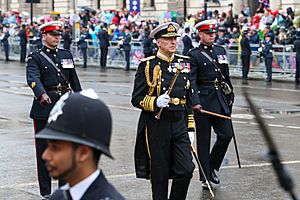Lord High Constable of England facts for kids
Quick facts for kids Lord High Constable of England |
|
|---|---|
|
Admiral Sir Tony Radakin, with the Lord High Constable's baton, at the coronation of King Charles III and Queen Camilla, 2023.
|
|
| Appointer | The Monarch |
| Term length | At His Majesty's Pleasure |
| Formation | 1139 |
| First holder | The 1st Earl of Hereford |
| Final holder | Admiral Sir Tony Radakin |
The Lord High Constable of England is a very old and important job in the United Kingdom. It's one of the seven "Great Officers of State," which are special roles that help the King or Queen. This job is usually only brought back for big events like a coronation.
Contents
What is the Lord High Constable?
The Lord High Constable is the seventh most important of the Great Officers of State. This means it ranks below the Lord Great Chamberlain and above the Earl Marshal.
Long ago, the Lord High Constable was like the main commander of the King's armies. They were also in charge of the King's horses, like a "Master of the Horse." Along with another officer called the Earl Marshal, they ran a special court. This court dealt with rules of honor and military law in olden times.
History of the Office
The job of Lord High Constable was first given in 1139. It was given by Empress Matilda to Miles of Gloucester, 1st Earl of Hereford. This job was passed down through his family, the Bohuns, who were earls of Hereford and Essex.
Later, the job went to the Stafford family, who were Dukes of Buckingham. But in the time of King Henry VIII, one of the Dukes, Edward Stafford, 3rd Duke of Buckingham, lost his titles. Because of this, the job of Lord High Constable became part of the Crown. This means it was no longer a separate, permanent job.
Since then, the office has only been brought back for special occasions. These occasions are usually when a new King or Queen is crowned. When the office is not active, the Earl Marshal takes care of its traditional duties.
There were also similar hereditary constables in other places. The Lacys and Verduns were hereditary constables of Ireland from the 12th to the 14th century. The Hays, earls of Erroll, have been hereditary Lord High Constables of Scotland since the early 14th century.
Lord High Constables of England (1139–1521)
Here are some of the people who held the permanent role of Lord High Constable before it became part of the Crown:
- 1139–1143: Miles of Gloucester, 1st Earl of Hereford
- 1143–1155: Roger Fitzmiles, 2nd Earl of Hereford
- 1155–1159: Walter of Hereford
- 1159–1164: Henry Fitzmiles
- 1164–1176: Humphrey III de Bohun
- 1176–1220: Henry de Bohun, 1st Earl of Hereford
- 1220–1275: Humphrey de Bohun, 2nd Earl of Hereford and 1st Earl of Essex
- 1275–1298: Humphrey de Bohun, 3rd Earl of Hereford and 2nd Earl of Essex
- 1298–1322: Humphrey de Bohun, 4th Earl of Hereford and 3rd Earl of Essex
- 1322–1336: John de Bohun, 5th Earl of Hereford and 4th Earl of Essex
- 1336–1361: Humphrey de Bohun, 6th Earl of Hereford and 5th Earl of Essex
- 1361–1373: Humphrey de Bohun, 7th Earl of Hereford, 6th Earl of Essex and 2nd Earl of Northampton
- 1373–1397: Thomas of Woodstock, 1st Duke of Gloucester
- 1397–1399: Humphrey, 2nd Earl of Buckingham
- 1399–1403: Henry Percy, 1st Earl of Northumberland
- 1403–?: John of Lancaster, 1st Duke of Bedford
- 1445–1450: John Beaumont, 1st Viscount Beaumont
- ?–1455: Edmund Beaufort, 2nd Duke of Somerset
- 1455: Humphrey Stafford, 1st Duke of Buckingham
- 1455–1456: Richard, Duke of York
- 1456–1460: Humphrey Stafford, 1st Duke of Buckingham
- 1461–1467: John Tiptoft, 1st Earl of Worcester
- 1467–1469: Richard Woodville, 1st Earl Rivers
- 1469–1470: Richard, Duke of Gloucester
- 1470–1471: John de Vere, 13th Earl of Oxford
- 1471–1483: Richard, Duke of Gloucester
- 1483: Henry Stafford, 2nd Duke of Buckingham
- 1483–1504: Thomas Stanley, 2nd Baron Stanley
- 1504–1521: Edward Stafford, 3rd Duke of Buckingham
Lord High Constables of England (1522–present)
Since 1522, the office has only been used for coronations. Here are the people who have held the role for these special events:
See also
- Constable of France, a similar office in France


